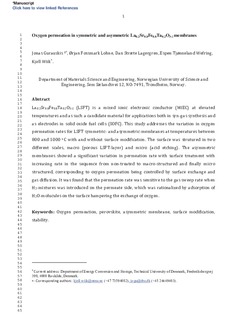| dc.contributor.author | Gurauskis, Jonas | |
| dc.contributor.author | Lohne, Ørjan Fossmark | |
| dc.contributor.author | Lagergren, Dan Stræte | |
| dc.contributor.author | Tjønneland Wefring, Espen | |
| dc.contributor.author | Wiik, Kjell | |
| dc.date.accessioned | 2017-11-03T13:37:28Z | |
| dc.date.available | 2017-11-03T13:37:28Z | |
| dc.date.created | 2017-01-30T12:02:06Z | |
| dc.date.issued | 2016 | |
| dc.identifier.citation | Journal of the European Ceramic Society. 2016, 36 (6), 1427-1434. | nb_NO |
| dc.identifier.issn | 0955-2219 | |
| dc.identifier.uri | http://hdl.handle.net/11250/2464029 | |
| dc.description.abstract | La0.2Sr0.8Fe0.8Ta0.2O3 − δ (LSFT) is a mixed ionic electronic conductor (MIEC) at elevated temperatures and as such a candidate material for applications both in syn-gas synthesis and as electrodes in solid oxide fuel cells (SOFC). This study addresses the variation in oxygen permeation rates for LSFT symmetric- and asymmetric-membranes at temperatures between 800 and 1000 °C with and without surface modification. The surface was structured in two different scales, macro (porous LSFT-layer) and micro (acid etching). The asymmetric membranes showed a significant variation in permeation rate with surface treatment with increasing rate in the sequence from non-treated to macro-structured and finally micro structured, corresponding to oxygen permeation being controlled by surface exchange and gas diffusion. It was found that the permeation rate was sensitive to the gas sweep rate when H2-mixtures was introduced on the permeate side, which was rationalized by the effect of H2O-diffusion across a gas film layer. | nb_NO |
| dc.language.iso | eng | nb_NO |
| dc.publisher | Elsevier | nb_NO |
| dc.rights | Attribution-NonCommercial-NoDerivatives 4.0 Internasjonal | * |
| dc.rights.uri | http://creativecommons.org/licenses/by-nc-nd/4.0/deed.no | * |
| dc.title | Oxygen permeation in symmetric and asymmetric La0.2Sr0.8Fe0.8Ta0.2O3-d membranes | nb_NO |
| dc.type | Journal article | nb_NO |
| dc.type | Peer reviewed | nb_NO |
| dc.description.version | acceptedVersion | nb_NO |
| dc.source.pagenumber | 1427-1434 | nb_NO |
| dc.source.volume | 36 | nb_NO |
| dc.source.journal | Journal of the European Ceramic Society | nb_NO |
| dc.source.issue | 6 | nb_NO |
| dc.identifier.doi | 10.1016/j.jeurceramsoc.2016.01.004 | |
| dc.identifier.cristin | 1441122 | |
| dc.relation.project | Norges forskningsråd: 191358 | nb_NO |
| dc.description.localcode | © 2016. This is the authors’ accepted and refereed manuscript to the article. LOCKED until 22.1.2018 due to copyright restrictions. This manuscript version is made available under the CC-BY-NC-ND 4.0 license http://creativecommons.org/licenses/by-nc-nd/4.0/ | nb_NO |
| cristin.unitcode | 194,66,35,0 | |
| cristin.unitname | Institutt for materialteknologi | |
| cristin.ispublished | true | |
| cristin.fulltext | postprint | |
| cristin.qualitycode | 1 | |

